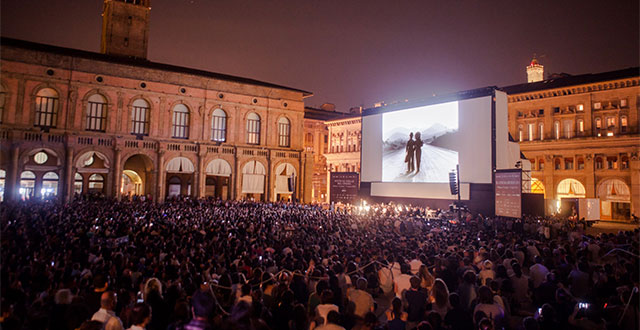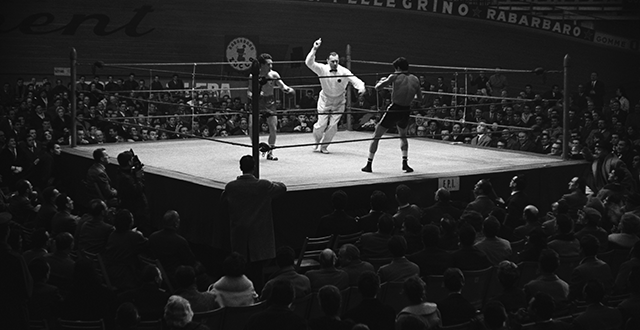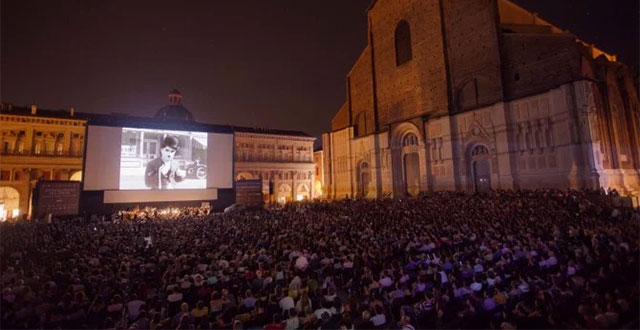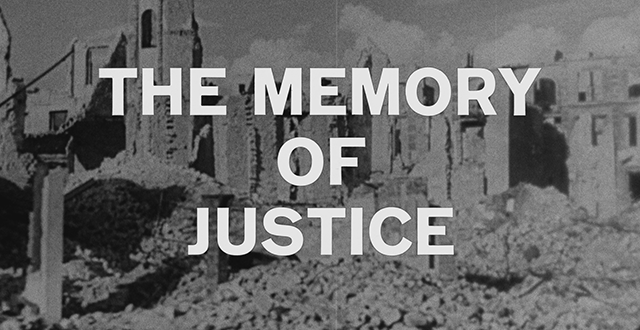News
The HFPA Honors Another Classic: Japan’s “Ugetsu Monogatari” at Bologna’s Cinema Ritrovato 2016
Armando Gallo
For the second year running the Hollywood Foreign Press Association enjoyed a special spot in the annual Il Cinema Ritrovato(Rediscovered Cinema) which takes place in Bologna, Italy. The festival showcases classic, rare and restored movies and has become a must-see event for cinephiles.
The HFPA has sponsored Martin Scorsese’s Film Foundation which has restored more than 90 classic films. This year one of those titles, the Japanese masterpiece Ugetsu Monogatari by legendary director Kenji Mizoguchi, was featured in all its original poetic beauty which was honored with the Venice’s Silver Lion in 1953.
The film was presented at the Arlecchino Cinema on the second day of the Festival to a sold out audience after an introduction by HFPA member Elisa Leonelli, herself an alumni of Bologna University, and Margaret Bodde, President of the Film Foundation who praised the generosity of HFPA for making Ugetsu and many other restorations possible. Martin Scorsese joined on by video message from New York, where he is still busy with his new film Silence.
“I first saw Ugetsu on TV in 1958”, he iconic director told the Arlecchino audience. “And I have been obsessed ever since by its beauty and poetry. It was very hard to find the various elements to restore and save this masterpiece and I have to thank our friends of the Hollywood Foreign Press for making it happen. We did a 4K digital restoration working from a master positive copy and a negative dupe. We worked at Cineric in New York and I had fantastic help from Masahiro Miyajima, who worked with cinematographer Kasuo Miyagawa for 30 years. I deeply love what Cinema Ritrovato and the town of Bologna is doing by showing these movies in the right way. I visited Bologna and the Cineteca, but not Cinema Ritrovato Festival and I promise to come soon.”
Every year the festival’s program expresses the power of film. Almost 500 titles were presented this year, from June 25 to July 3, at the Bologna Cineteca 4-screen complex and in various theaters in the center of this vibrant Italian city. Over 100.000 spectators celebrated the Festival’s 30th anniversary with an international audience: 3.500 festival passes sold to visitors coming from more than 50 different countries. 500 film archivists and FIAF members came from all over the world.
The historic Piazza Maggiore, a jewel of Italian Renaissance, is the setting for the festival’s free open air screenings. It was very appropriate that Cinema Ritrovato would open June 25th in the Piazza with Charlie Chaplin’s classic masterpiece Modern Times with the accompaniment of a full orchestra. During the week Chaplin’s The Kid (1922) was also shown and its soundtrack, scored by Chaplin himself for the television version of the movie, was rediscovered and performed for the first time in its entirety by the excellent Orchestra Comunale di Bologna. Buster Keaton’s movies had the same inspiring presentation.
Italian film critic and lecturer Giuliana Muscio added that Cinema Ritrovato has been kind of a secret for international aficionados, “But things are changing,” she said. “People now come from all over world. Alexander Payne and George Lucas are just some of the people who restore movies privately and then show them here. On opening night I saw whole families at Chaplin’s Modern Times and heard parents explaining to the children behind me why Chaplin makes fun of the unions and fights for the workers. It is very important to see the great memories of film of the past to do better for tomorrow.”
"Cinema Ritrovato also creates new audiences for silent films and restored masterpieces with no borders. Again, the HFPA can become a valid sponsor of Cinema Ritrovato; not just for the money you already give, but also having a voice in what needs to be done and restored.”
Martin Scorsese on Visconti’s Rocco and His Brothers
Martin Scorsese
The film-maker pays tribute to Luchino Visconti, whose cinematic masterpiece Rocco and His Brothers has been restored to its original glory.
Luchino Visconti was one of the greatest artists in the history of cinema. He had a fascinating life, which was intertwined with many different strands of European art and culture.
Visconti came from the Milanese branch of one of Europe’s oldest families, whose roots can be traced back to the early 13th century. He might have appeared as a character in one of his own films about the aristocracy, such as Senso or The Leopard – that’s the life he was born into. But at a certain point in the 1930s, his passion for theatre, opera and the cinema set him on a radically different path.
Visconti had a kind of apprenticeship with Jean Renoir and worked as an assistant on some of the pictures he made during the period when he was associated with the French Popular Front – Renoir was actually the one that gave him the idea for his first film, Ossessione, an adaptation of The Postman Always Rings Twice. Visconti’s artistic and political lives became almost one and the same – he started making films and directing theatre during the war years, the same period in which he joined the Communist party and worked with the Resistance.
He has often been referred to as a great political artist, but that’s too limiting and frozen a description. His sense of European history was vast and he knew the lives of the rich and powerful first hand – but at a certain point he became drawn to understand the other side of life, that of the poor and powerless. He had a strong sense of the particular manner in which absolutely everyone, from the Sicilian fishermen in his neorealist classic La Terra Trema to the Venetian aristocrats in Senso, was affected by the grand movements of history.
Visconti directed 14 features in his lifetime, each one extraordinary. Some, such as Senso, The Leopard and Rocco e i suoi Fratelli [Rocco and His Brothers], are among the greatest in the history of the art form. Written by Visconti and his long-time collaborator Suso Cecchi D’Amico (along with the contributions of four other writers), Rocco was based on elements of Ghisolfa Bridge by the Milanese writer Giovanni Testori, but it was also inspired by themes found in Thomas Mann’s Joseph and His Brothers and Dostoyevsky’s The Idiot. Visconti follows the fortunes of Rocco (Alain Delon) and his three brothers Simone (Renato Salvatori), Ciro (Max Cartier) and Luca (Rocco Vidolazzi), who travel with their mother (Katina Paxinou) from south to north in search of a better life. Unlike Senso and The Leopard, Rocco was set in the present, which at the time was in the midst of the industrial and economic boom that transformed Italy during the mid-1960s. The picture is about the effects of life in this new world on the family, which gradually comes apart at the seams.
When Rocco and His Brothers came out, in 1960, a lot of people criticised it for what they perceived as emotional excess. It is operatic, as were all of Visconti’s films, but the remarks about excess made no sense to me. Rocco is Italian culture. I grew up in Italian-American culture, but there wasn’t much of a difference. For us – that is, me and my family and my friends – the physical and emotional expressiveness of the characters in the film, Katina Paxinou’s character in particular, seemed like an accurate and only slightly heightened reflection of the life we knew. We all saw that kind of ‘excess’ on a regular basis.
Rocco is one of the most sumptuous black-and-white pictures I’ve ever seen. The images, shot by the great Giuseppe Rotunno, are pearly, elegant and lustrous – it’s like a simultaneous continuation and development of neorealism. Thanks to Gucci and The Film Foundation and our friends at the Cineteca di Bologna, Luchino Visconti’s masterpiece can be experienced once again in all its fearsome beauty and power.
MARTIN SCORSESE, founder and chair of The Film Foundation, is a director, producer, screenwriter, actor and film historian, and widely regarded as one of the most significant and influential film-makers in cinema history; film-foundation.org
Charlie Chaplin’s ‘Modern Times’ Still Packs Them In
Nick Vivarelli
Marlon Brando is also being celebrated at the Cinema Ritrovato festival, dedicated to rediscovered classics.
ROME — Charlie Chaplin’s “Modern Times” can still draw a massive crowd after 80 years.
An estimated 7,000 spectators packed Bologna’s Piazza Maggiore square to catch the 1936 classic starring Chaplin and Paulette Goddard in a restored version with live musical accompaniment on Saturday, as it opened the 30th edition of the Il Cinema Ritrovato festival dedicated to rediscovered gems.
Directors Jean-Pierre and Luc Dardenne, Bernardo Bertolucci, Ermanno Olmi, and Cannes Film Festival artistic director Thierry Fremaux are among guests of this year’s 30th edition of Cinema Ritrovato, which will run through July 2. Fremaux, who also heads the Lumiere Institute in Lyon, inaugurated a photo exhibition dedicated to the Lumiere Brothers, cinema’s most illustrious pioneers.
The Dardenne brothers Sunday night introduced the freshly restored copy of their 1996 breakthrough feature “La Promesse” (“The Promise”), on the timely topic of immigration in Europe. Bertolucci and cinematographer Vittorio Storaro (“Apocalypse Now”) will be reminiscing this week about Marlon Brando, whom Bertolucci directed in “Last Tango in Paris.” Brando’s sole directorial effort, the Western “One-Eyed Jacks,” restored by Martin Scorsese’s The Film Foundation, is also screening. Olmi will be presenting the world premiere of the restored print of his Italian peasant drama “The Tree of Woden Clogs,” which won the 1978 Cannes Palme d’Or.
The event is run by Italy’s Cineteca di Bologna, the prominent film archives known globally as a prime film-preservation entity. After dedicating more than a decade to the restoration of Charlie Chaplin’s entire oeuvre, it is currently working on a multiyear project to restore all of Buster Keaton’s films, in tandem with New York-based Cohen Media Group.
The first fruits of this collaboration, fresh restorations of Keaton shorts “The High Sign” and “Cops,” are screening Tuesday after Chaplin’s “The Kid.”
Footage Award Winners Honoured at FOCAL's 13th Annual Gala Awards
|
The 13th annual FOCAL International Awards in association with AP Archive took place last Thursday night before a full house at The Lancaster London Hotel. Now well into their second decade and going strong, The FOCAL International Awards celebrate the best use of footage in all variety of genres, across all media platforms, with the 2016 event showing strength from around the global production community.
|
London, UK - 31 May 2016
The 13th annual FOCAL International Awards in association with AP Archive took place last Thursday night at The Lancaster London Hotel, honouring producers, filmmakers and other creative professionals who have used library footage in a documentary, feature film or any other form of production released in 2015. The BBC's Kate Adie hosted the gala ceremony, which also served as an occasion to bid farewell to event organizer Julie Lewis, who is retiring from FOCAL this year. Under Lewis's leadership, the FOCAL Awards have evolved over the last decade into a major event in the archival production community.
Awards in sixteen categories, including Lifetime Achievement, were handed out and several high-profile documentaries took home top honours. Academy Award Winner Amy, about the life of Amy Winehouse, won the Award for Best Use of Footage in both the Music Production and Cinema Release categories, edging out Cobain: Montage of Heck in both categories. Archive Producer Paul Bell was there to collect both awards and spoke of the 'importance of giving creative people the space they need to find the stories that already exist in the archive'.
The Black Panthers: Vanguard of the Revolution directed by Stanley Nelson won for Best Use of Footage in a Factual Production. Accepting the award in a pre-recorded video, Nelson said, 'Archival footage is a real part of what we do - I look at it as another character in the film, so to win an award for its usage is amazing.'
Best of Enemies featuring the acerbic public debates between Gore Vidal and William F. Buckley Jr, which was short listed twice, prevailed in the Entertainment category. The BBC's Imagine strand saw off Arena: Night and Day, celebrating 40 years of the their longest running Arts series, with The Ecstasy of Wilko Johnson directed by Julien Temple. Ray Davies, formerly of the Kinks, was there to hand over the award as Patron of London's Screen Archives.
Twenty-five European films were shortlisted for this year's FOCAL International Awards. Among them, Every Face Has a Name, from Swedish production company Auto Images, won for the Best Use of Footage in a History Production, beating A German Youth from Local Films (France) and Red Gold from Vivement Lundi (France) whilst the Award for Best use of Sports Footage was collected by Yuzu Productions (France) for Free To Run.
The FOCAL Awards also honour the work of archival researchers, footage archivists and film preservationists, with this year's Lifetime achievement award going to legendary film preservationist Robert Gitt. In a career spanning more than fifty years, Robert Gitt has gained an international reputation as one of the foremost experts in the preservation and restoration of motion pictures.
In an emotional speech, Berman-Bogdan said, 'I've been a Researcher for 35 plus years. I've worked on a lot of amazing films which have won a lot of awards, but this is the first time that I, personally, have ever won an award for my achievements, so I want to thank FOCAL for recognising Researchers and all that Archives do.'
Historic Films won the Library of the Year Award, and Tim Emblem-English formerly of BBC Studios and Post Production won for Footage Employee of the Year.
The Best Archive Restoration/Preservation Award went to The Memory of Justice and was collected by The Film Foundation's, Margaret Bodde.
Please see below for a full list of all 2016 FOCAL International Awards winners.
FOLLOW THE LINKS:
Best Use of Footage in a History Production - Sponsored by Getty Images / BBC Motion Gallery
* Every Face Has a Name - Auto Images (Sweden) Best Use of Footage in a Current Affairs Production - Sponsored by Bloomberg Content Service
* The Queen of Ireland - Blinder Films (Ireland) Best Use of Footage in a Factual Production - Sponsored by Bridgeman Footage
* The Black Panthers: Vanguard of the Revolution - Firelight Films, Inc (USA) Best Use of Footage in an Entertainment Production - Sponsored by FremantleMedia Archive
* Best of Enemies - Tremolo Productions / Magnolia Pictures (USA) Best Use of Footage in an Arts Production - Sponsored by Film London & London's Screen Archives
* Imagine: The Ecstasy of Wilko Johnson - Essential Arts Entertainment/Nitrate Film//BBC (UK) Best Use of Footage in a Music Production - Sponsored by Shutterstock
* Amy - On The Corner (UK) Best Use of Sports Footage - Sponsored by ITV Sport Archive
* Free to Run - Yuzu Productions (France) Point Prod (Switzerland) and Eklektik Productions (Belgium) Best Use of Footage in an Advert or Short Production - Sponsored by Broadcast Tech
* Lenor 'Odes to Clothes: Marvellous Scarf' - The Director Studio for Grey Düsseldorf (UK/Germany) Best use of Footage about the Natural World - Sponsored by Global ImageWorks
* The Nature of Things: Jellyfish Rule! - CBC (Canada) Best Use of Footage on non-Television Platforms - Sponsored by Visual Data
* The Beatles 1+ Video Collection - Apple Corps Limited (UK) Best Archive Restoration / Preservation Project or Title - Sponsored by Prasad Corp
* The Memory of Justice - The Film Foundation / Academy Film Archive (USA) The Jane Mercer Footage Researcher of the Year Award - Sponsored by AP Archive
* Jessica Berman-Bogdan (USA) for Cobain: Montage of Heck and Narcos Footage Employee of the Year- Sponsored by Creative Skillset
* Tim Emblem English (BBC Studios and Post Production) Footage Library of the Year - Sponsored by Bonded Services
* Historic Films Archive - ENDS -
ABOUT FOCAL INTERNATIONAL
The Federation of Commercial Audiovisual Libraries International is a professional not-for-profit trade association formed in 1985. It is fully established as one of the leading voices in the industry, with a membership of over 300 international companies and individuals. Its purpose is to facilitate the use of library footage, images, stills and audio in all forms of media production; promote its members - libraries selling content plus those whose serve the industry; provide a platform for members to promote themselves and their interests; encourage good practise in the research, licensing, copyright clearance and use of footage; support, promote and educate on the need to preserve and restore footage and content; act as an information resource for the footage and content industry; offer training in key skills and in the broader appreciation of the footage and content industry. 79 College Road, Harrow, Middx, HA1 1BD, UK
|










